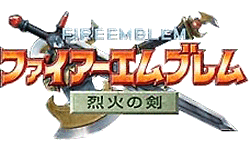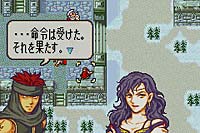|
|

|
BATTLE SYSTEM
|

|
INTERACTION
|

|
ORIGINALITY
|

|
STORY
|

|
MUSIC & SOUND
|

|
VISUALS
|

|
CHALLENGE
|
Electrifying
|
COMPLETION TIME
|
~30 hours
|
|
OVERALL
5.0/5
|
Rating definitions
|
|
|
Such a storied history the Fire Emblem series has in Japan. Originating on the Famicom, the series migrated to the Super Famicom, skipped out on the Nintendo 64 in favor of sticking with the Super Famicom long after most developers had forgotten it, then went to the Game Boy Advance. And it is with the Game Boy Advance’s second installment of Fire Emblem that English speakers were finally granted the ability to play one of these games legally. The result of Nintendo’s translation effort is a Tactical-RPG eminent in the field, and highly deserving of any RPGamer’s time.
Fire Emblem’s tale takes place in the same world its immediate predecessor in the series, Fire Emblem: Fuuin no Tsurugi, did. Set 20 years before the events in Fuuin no Tsurugi, this Fire Emblem at first takes the player through a story of a young woman named Lyn being found by a pair of knights who have identified her as the only surviving relative of the now-aged Marquis of Caelin. This naturally wends into complications, as a usurper to the throne wants to get Lyn out of the way, but Lyn’s quest is an introduction to the Fire Emblem playing style for those who have not partaken of it before. The main story begins one year later, as Eliwood (eventual father of the well-known Roy and heir to the nation of Pherae) seeks the whereabouts of his own father in the company of his good friend Hector of Ostia. Such a task is harder than it initially seems, and Eliwood and Hector run afoul of various persons allied with a criminal organization known as the Black Fang. They also run into Lyn after awhile, and she allies herself with them. Eventually it becomes clear that a nefarious man named Nergal is behind all the troubles, and for the peace of the land he must be stopped. This bare-bones telling of the story does not take into account a number of interesting side chapters and the potential for support conversations that grant insight into the lives of the people who will accompany the three lords on their quest.
 …I told you, I’m allergic to cats. Clean the box yourself.
…I told you, I’m allergic to cats. Clean the box yourself.
|
|
The story is at any rate inconsequential when set alongside the Fire Emblem battle system. Fire Emblem looks similar to Shining Force (fitting, since Shining Force on the Genesis borrowed its overhead look from Fire Emblem). In the most overarching sense the two play similarly also, with characters moving from an overhead perspective and performing actions in a brief cut-scene before going back to the overhead map. Fire Emblem varies from early Shining Forces in a number of ways however. The weapons triangle as it exists here is simultaneously simple and complex – swords have an advantage over axes, axes have an advantage over lances, lances have an advantage over swords. This simple formula is inverted by certain weapons that reverse the triangle however. The lances and axes also have longer-range weapons that come with lower accuracy. Swords have no distance attacks (excepting two types later on that count as magic instead) but compensate by being light and accurate. Weight also matters here, as every character has a constitution. If a character’s constitution is less than the weight of a weapon, the difference is deducted from the character’s speed. Speed allows for a double attack, a single attack, or the enemy to double attack. Bows and arrows have an advantage over flying adversaries, but otherwise have the sole benefit of allowing for distance attacks. Magic has its own triangle of anima (nature) triumphing over light magic, light magic triumphing over dark magic, and dark magic triumphing over anima.
Taking action against the enemy nets experience for the character to perform it, killing an enemy nets more experience than simply attacking it. 100 experience results in a level-up for a character, and at any point from level 10 to level 20 (at which time experience is no longer gained) characters can promote with the use of promotion items that work with their class. Upon promotion a new ability and/or new weapon use is added and levels can be gained once more. Simplicity melded with complexity – it is to be found seeped into every bit of Fire Emblem.
Interaction is very easy. Menus that have evolved throughout the series are positioned ideally to tell what the player needs to know. Upon choosing to attack, the player will see a quick display telling the probability of hitting the enemy, the damage that will be done if the attack hits, and the probability of a critical attack (critical attacks do triple damage). Prior to battle the starting enemy positions and statistics can be observed (unless the battle takes place under darkness), allowing the player to best plan out the characters necessary to triumph. Exchanging items between characters is more time-consuming than would be ideal, but not a big deal. Shop menus are easy to navigate as well, although it is rare to have the opportunity to shop at leisure since most shops are located on the battlefield.
 Having all of this in Japanese might obscure the fact that Rebecca is, in fact, level 1. Believe it or not, she gets better.
Having all of this in Japanese might obscure the fact that Rebecca is, in fact, level 1. Believe it or not, she gets better.
|
|
Visually Fire Emblem is not trying to compete with the most resplendent items available on GBA. Having said this, many of the critical attacks to be seen in battle look just right for instilling a painful feel to them. There is quite a bit of artwork to be seen in the game, and these pieces look very good. Aurally Fire Emblem has a reasonable number of tracks, and most of them are rather good. For certain reasons however, the player will be hearing them very frequently – which may impinge upon enjoyment.
The reason a player may have to hear certain music very frequently is due to a central characteristic of the Fire Emblem series; its challenge. More specifically, the fact that a character fallen in battle is dead. There is no resurrection in Fire Emblem. Thus, if the player wants to preserve that character, restarting the battle is mandatory. And if one of the three lords (Eliwood, Hector, and Lyn) falls, then Game Over results and battles are mandatory for everyone. Healing is accomplished via items, dedicated healers, and gradual HP recovery on a castle – but losing characters in battle is easy to do with a moment’s inattention. Fire Emblem packs a good challenge, then, although it pales next to its predecessors in the series.
Completing Fire Emblem will probably take between 30 and 40 hours. Once completed, however, the incentives for replay are massive. First, the option to play from Hector’s point of view (enabled by finishing Eliwood’s quest) is strongly encouraged, as the battles and the story change significantly. There is also the temptation to obtain every support conversation between characters, as these conversations reveal quite a bit that would never otherwise be known about the characters. There is a sound test feature that allows all music from the game to be heard – but only if the player has heard it once within the game. And there is the temptation to play Hard Mode – Eliwood’s Hard Mode is not an enormous stress-inducing scenario, but Hector’s Hard Mode can induce fits of anger among the unprepared. Completing it is the mark of one who is ready for an earlier Fire Emblem title.
Lovers of challenging Tactical-RPGs who have somehow avoided Fire Emblem are hereby instructed to seek it out. Lovers of Tactical-RPGs in general should seek it out, but with the warning that its challenge is not for the faint of heart. RPGamers who dislike challenging games should still try it out, but not with the wholehearted recommendation given to others. Fire Emblem is not easy, but it is an incredibly polished title that is insanely addictive even after characters have died left and right in repeated trials of battles.
Review Archives
|









